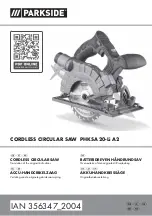
-37-
W1761/W1762 12" Table Saw with Riving Knife
O
PE
R
AT
IO
N
S
To cut rabbets with the standard blade, do these steps:
Note:
Cutting rabbets with a standard saw blade
DOES NOT require the use of a sacrificial fence.
Note:
Reduce motor overloading and blade wear by using
a ripping blade. Ripping blades are designed to clear the
sawdust quickly.
1.
DISCONNECT THE SAW FROM POWER!
2.
Ensure that the riving knife is installed.
3.
Clearly mark the width of the rabbet cut on the
workpiece.
Note:
Include marks on the edge of the workpiece
to clearly identify the intended cut while it is laying
flat on the saw table.
4.
Raise the blade up to the desired depth of cut
(depth of rabbet channel desired). When cutting
deep rabbets, take more than one pass to reduce
the risk of kickback.
The danger of kickback increases relative to the
depth and width of a cut. Reduce the risk of kickback
by making multiple passes to achieve the desired
depth of cut. Failure to follow these warnings could
result in serious personal injury.
�����
���������
���������
Figure 53.
First cut to create a rabbet
with a standard blade.
�����
���������
���������
Figure 54.
Second cut to create a rabbet.
5.
Adjust the fence so the blade is aligned with the
inside of your rabbet channel as shown in
Figure 53
.
6.
Reconnect the saw to the power source and turn the
saw
ON
.
7.
When the blade has reached full speed, perform a
test cut with a scrap piece of wood.
8.
If the cut is satisfactory, repeat the cut with the
final workpiece.
9.
Stand the workpiece on edge as shown in
Figure 54
.
10.
Adjust the saw blade height to intersect with the
first cut.
11.
Perform the second cut to complete the rabbet.
Summary of Contents for W1761
Page 14: ......
Page 17: ...3 W1761 W1762 12 Table Saw with Riving Knife INTRODUCTION...
Page 18: ...4 W1761 W1762 12 Table Saw with Riving Knife INTRODUCTION...
Page 77: ...63 W1761 W1762 12 Table Saw with Riving Knife PARTS Main Table Motor Cabinet...
Page 83: ......
Page 84: ......
Page 87: ......
Page 88: ......
















































